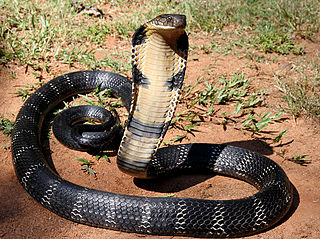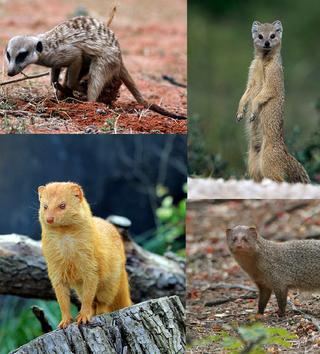
The king cobra is a venomous snake endemic to Asia. The sole member of the genus Ophiophagus, it is not taxonomically a true cobra, despite its common name and some resemblance. With an average length of 3.18 to 4 m and a record length of 5.85 m (19.2 ft), it is the world's longest venomous snake. The species has diversified colouration across habitats, from black with white stripes to unbroken brownish grey. The king cobra is widely distributed albeit not commonly seen, with a range spanning from the Indian Subcontinent through Southeastern Asia to Southern China. It preys chiefly on other snakes, including those of its own kind. This is the only ophidian that constructs an above-ground nest for its eggs, which are purposefully and meticulously gathered and protected by the female throughout the incubation period.

A mongoose is a small terrestrial carnivorous mammal belonging to the family Herpestidae. This family is currently split into two subfamilies, the Herpestinae and the Mungotinae. The Herpestinae comprises 23 living species that are native to southern Europe, Africa and Asia, whereas the Mungotinae comprises 11 species native to Africa. The Herpestidae originated about 21.8 ± 3.6 million years ago in the Early Miocene and genetically diverged into two main genetic lineages between 19.1 and 18.5 ± 3.5 million years ago.

Colubridae is a family of snakes. With 249 genera, it is the largest snake family. The earliest fossil species of the family date back to the Late Eocene epoch, with earlier origins suspected. Colubrid snakes are found on every continent except Antarctica.
François Marie Daudin was a French zoologist.

George Albert Boulenger was a Belgian-British zoologist who described and gave scientific names to over 2,000 new animal species, chiefly fish, reptiles, and amphibians. Boulenger was also an active botanist during the last 30 years of his life, especially in the study of roses.

Styrax is a genus of about 130 species of large shrubs or small trees in the family Styracaceae, mostly native to warm temperate to tropical regions of the Northern Hemisphere, with the majority in eastern and southeastern Asia, but also crossing the equator in South America. The resin obtained from the tree is called benzoin or storax.

Oxybelis aeneus, commonly known as the Mexican vine snake or brown vine snake, is a species of colubrid snake, which is endemic to the Americas.

The eastern brown snake, often referred to as the common brown snake, is a species of extremely venomous snake in the family Elapidae. The species is native to eastern and central Australia and southern New Guinea. It was first described by André Marie Constant Duméril, Gabriel Bibron, and Auguste Duméril in 1854. The adult eastern brown snake has a slender build and can grow to 2 m (7 ft) in length. The colour of its surface ranges from pale brown to black, while its underside is pale cream-yellow, often with orange or grey splotches. The eastern brown snake is found in most habitats except dense forests, often in farmland and on the outskirts of urban areas, as such places are populated by its main prey, the house mouse. The species is oviparous. The International Union for Conservation of Nature classifies the snake as a least-concern species, though its status in New Guinea is unclear.

Toxicofera is a proposed clade of scaled reptiles (squamates) that includes the Serpentes (snakes), Anguimorpha and Iguania. Toxicofera contains about 4,600 species, of extant Squamata. It encompasses all venomous reptile species, as well as numerous related non-venomous species. There is little morphological evidence to support this grouping; however, it has been recovered by all molecular analyses as of 2012.

Python is a genus of constricting snakes in the Pythonidae family native to the tropics and subtropics of the Eastern Hemisphere.

The Colubrinae are a subfamily of the family Colubridae of snakes. It includes numerous genera, and although taxonomic sources often disagree on the exact number, The Reptile Database lists 717 species in 92 genera as of September 2019. It is the second largest subfamily of colubrids, after Dipsadinae. Many of the most commonly known snakes are members of this subfamily, including rat snakes, king snakes, milk snakes, vine snakes, and indigo snakes.

Monodactylus argenteus is a species of fish in the family Monodactylidae, the moonyfishes. Its common names include silver moonyfish, or silver moony, butter bream, and diamondfish. It is native to the western Pacific and Indian Oceans, including the Persian Gulf, Red Sea, and associated estuaries, such as the Mekong Delta.
Caryospora is a genus of parasitic protozoa in the phylum Apicomplexa. The species in this genus infect birds and reptiles with the majority of described species infecting snakes. It is the third largest genus in the family Eimeriidae.

Dipsadinae is a large subfamily of colubroid snakes, sometimes referred to as a family (Dipsadidae). They are found in most of the Americas, including the West Indies, and are most diverse in South America. There are more than 700 species.

The Colubroides are a clade in the suborder Serpentes (snakes). It contains over 85% of all the extant species of snakes. The largest family is Colubridae, but it also includes at least six other families, at least four of which were once classified as "Colubridae" before molecular phylogenetics helped in understanding their relationships. It has been found to be monophyletic.

Afrophidia is a clade of alethinophidian snakes comprising the groups Henophidia and Caenophidia, essentially making up the snakes people commonly associate with. The name refers to the deep split between Afrophidia and their sister taxon, Amerophidia, which originated in South American origin, and the afrophidians was recently hypothesized to represent a vicariant event of the breakup of Gondwanan South America and Africa.

The Elapoidea are a superfamily of snakes in the clade Colubroides, traditionally comprising the families Lamprophiidae and Elapidae. Advanced genomic sequence studies, however, have found lamprophiids to be paraphyletic in respect to elapids, and anywhere between four and nine families are now recognized.
Staphylococcus argenteus are gram-positive cocci from the genus Staphylococcus which have been isolated from blood culture of a 55-year-old Indigenous Australian female in 2006 in Darwin, Northern Territory, Australia. The species is close related to S. aureus and the differentiation is challenging. Staphylococcus argenteus is cytotoxic to human cells due to high expression of alpha-hemolysin.
Xenoxybelis is a genus of colubrid snakes endemic to South America.
Xenoxybelis boulengeri, the southern sharpnose snake, is a species of snake in the family, Colubridae. It is found in Brazil, Peru, and Bolivia.















